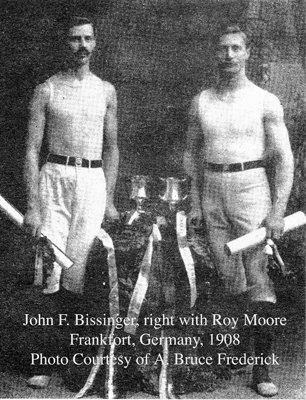John Bissinger competed in only the third summer Olympic Games (1904), so it appears that he is probably the earliest competitor among Gymnastic Hall of Fame Honorees. Actually, the winter games were added in 1924. The Olympics were not intended to be a competition among nations. It was a competition among amateur athletes from around the world. It was the job of the athlete to find a way to the games at personal expense. Like Glenn Berry, John competed in a unique Olympics filled with what today would be considered decadent decisions and behaviors, but he made his way to St. Louis and distinguished himself in two sports during this unique toddler stage of the “modern” Olympics.
Olympic Games: Gymnastics Artistic Individual AA-8th; Silver-Team Combined Exercises, St. Louis, Missouri, 1904. Track & Field: Silver-Triathlon-shot putt, dash, & broad jump, St. Louis, Missouri, 1904. National Amateur Athletic Union (NAAU) Championships: Gold-AA, 1901 & 1903; Gold-HB, 1901; Gold-V, 1898, 1900, 1903; Gold-PH, (1899, 1900-’01, 1903). General: John received his training at the New York Turnverein, and he taught the basics to Roy E. Moore. Of note is that a second American gymnast, George Eyser, won two gold, two silver, and one bronze medal at the 1904 games. A fine feat since he had one real leg, the other being made of wood. The Games: “Originally scheduled for Chicago, President Roosevelt urged a change to St. Louis since the Louisiana Purchase (World) Exposition was being held there at the same time to showcase the world’s newest technologies (electricity, automobiles, airplanes, etc. In any case, travel was so expensive that the participants were mostly Americans and Canadians for a total of 681 athletes, 525 from the U.S. The entire series of Olympic games lasted for just five days, August 29 to September 3rd.” The St. Louis Games were basically a tragedy in more than one way. “If you were a minority, you competed in separate games named Anthropology Days held on August 12 and 13, 1904. These games were designed to face costumed members of the uncivilized tribes against one another in the never to be classic events of mud fighting, rock throwing, pole climbing, etc. In swimming two judges had a down-to-earth brawl, and the Marathon was a farce with the first man across the finish line being disqualified since he was seen riding in an auto at about the half way point.” There’s more but suffice it to say that an interim games was held in 1906 in Athens. The games were not numbered but twenty countries attended and it did help to put the Olympics back on a course toward success.

